12.11.1998
Painter – Artsymenev Y.
Stamps per sheets: 25 (5x5 stamps).
Paper - coated; manufacturing process - offset; perforation - comb 12.
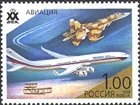 |
||
Aviation. Aviation started with the flight of the Wright brothers, Orwell (1871-1948) and Wilber (1867-1912), American constructors and pilots, the pioneers of aviation. On 17 December 1903 they performed four flights on Flyer-1 aircraft, an aircraft with the internal combustion engine, which they created. Military aviation was widely used for the first time during the WWI, and after it finished, civil air transportation began to blossom. The development of aviation had a great impact on the technical progress of society. The stamp features the Wright brothers' plane (below), Il-96, a passenger aircraft (centre), and SU-37, a military aircraft (above).
| Face value | Size | Description | Price, mint | Price, used | Quantity |
|---|---|---|---|---|---|
| 1.00 | 50×37 | Aviation. Aviation started with the flight of the Wright brothers, Orwell (1871-1948) and Wilber (1867-1912), American constructors and pilots, the pioneers of aviation. On 17 December 1903 they performed four flights on Flyer-1 aircraft, an aircraft with the internal combustion engine, which they created. Military aviation was widely used for the first time during the WWI, and after it finished, civil air transportation began to blossom. The development of aviation had a great impact on the technical progress of society. The stamp features the Wright brothers' plane (below), Il-96, a passenger aircraft (centre), and SU-37, a military aircraft (above). multicolor |
1.00 | 0.20 | 250000 |
№ 470
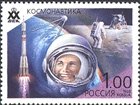 |
||
Astronautics. In early 20c Russian scientist K.E.Tsiolkovsky (1857-1935) was the first to substantiate that it is possible to use rockets for interplanet voyages, and provided engineering solutions for rockets construction. The Era of Austronautics began on 4 October 1957, when the first sputnik was launched in the USSR. The stamp features the compositions representing the stages of astronautics development. The centre of the stamp shows the portrait of Yuri Gagarin, the first astronaut (1934-1968), who was the first man to fly to the space on "Vostok" spacecraft on 12 April 1961. In the right part of the stamp there is a US astronaut and the moon craft "Eagle" on the surface of the Moon. The crew of Apollo 11 (N.Armstrong, E.Aldrin, M.Collins) was the first ever fly to the surface of the Moon on 16.07-24.07.1969. In the left part of the stamp there is a three-stage carrier rocket Soyuz. In the upper part of the stamp there is the first ever artificial sputnik of the Earth.
| Face value | Size | Description | Price, mint | Price, used | Quantity |
|---|---|---|---|---|---|
| 1.00 | 50×37 | Astronautics. In early 20c Russian scientist K.E.Tsiolkovsky (1857-1935) was the first to substantiate that it is possible to use rockets for interplanet voyages, and provided engineering solutions for rockets construction. The Era of Austronautics began on 4 October 1957, when the first sputnik was launched in the USSR. The stamp features the compositions representing the stages of astronautics development. The centre of the stamp shows the portrait of Yuri Gagarin, the first astronaut (1934-1968), who was the first man to fly to the space on "Vostok" spacecraft on 12 April 1961. In the right part of the stamp there is a US astronaut and the moon craft "Eagle" on the surface of the Moon. The crew of Apollo 11 (N.Armstrong, E.Aldrin, M.Collins) was the first ever fly to the surface of the Moon on 16.07-24.07.1969. In the left part of the stamp there is a three-stage carrier rocket Soyuz. In the upper part of the stamp there is the first ever artificial sputnik of the Earth. multicolor |
1.00 | 0.20 | 250000 |
№ 471
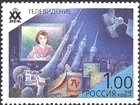 |
||
Telelvision. A sphere of science, technic and culture dealing with telecasting of moving images via radioelectronic devices. In the 1930s the first electronic telesystems appeared. Television is the most popular mass media. It is also widely used in science, medicine, and other areas. The stamp features the symbols of modern television, i.e. teletowers from Moscow, Shanghai, London, and Berlin against the background of a city at night; a telecomms sputnik; a TV camera-man; a TV-presenter on the silver screen.
| Face value | Size | Description | Price, mint | Price, used | Quantity |
|---|---|---|---|---|---|
| 1.00 | 50×37 | Telelvision. A sphere of science, technic and culture dealing with telecasting of moving images via radioelectronic devices. In the 1930s the first electronic telesystems appeared. Television is the most popular mass media. It is also widely used in science, medicine, and other areas. The stamp features the symbols of modern television, i.e. teletowers from Moscow, Shanghai, London, and Berlin against the background of a city at night; a telecomms sputnik; a TV camera-man; a TV-presenter on the silver screen. multicolor |
1.00 | 0.20 | 250000 |
№ 472
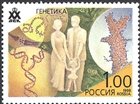 |
||
Genetics. The science which deals with the laws of heredity and mutations and ways of manipulating them. The rapid development of genetics in the 20c, particularly of molecular genetics, allowed to reveal the structure of genetic material and understand the way it works. Ideas and methods of genetics are widely used in medicine, agriculture, microbiology, its achievements triggered the development of genetic engineering and biotechnology. The stamp shows the symbols of genetics: in the centre of the stamp there is a family, on the left there is a DNA sample. In the upper and in the right part of the stamp chromosomes are shown at various stages of division. The cell division ensures succession of chromosomes in generations of cells.
| Face value | Size | Description | Price, mint | Price, used | Quantity |
|---|---|---|---|---|---|
| 1.00 | 50×37 | Genetics. The science which deals with the laws of heredity and mutations and ways of manipulating them. The rapid development of genetics in the 20c, particularly of molecular genetics, allowed to reveal the structure of genetic material and understand the way it works. Ideas and methods of genetics are widely used in medicine, agriculture, microbiology, its achievements triggered the development of genetic engineering and biotechnology. The stamp shows the symbols of genetics: in the centre of the stamp there is a family, on the left there is a DNA sample. In the upper and in the right part of the stamp chromosomes are shown at various stages of division. The cell division ensures succession of chromosomes in generations of cells. multicolor |
1.00 | 0.20 | 250000 |
№ 473
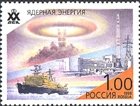 |
||
Nuclear Energy. The internal energy of nucleus which is released at nuclear transformations. Initially used to produce explosives (nuclear bombs), it was later used as the source of electric energy. The first nuclear power station (NPS) was launched in the USSR in 1954. Nuclear power plants which transform thermal energy of the reactor into mechanical or electric energy, are used on ice-boats and military ships. The stamp features a composition showing various applications of nuclear energy.
| Face value | Size | Description | Price, mint | Price, used | Quantity |
|---|---|---|---|---|---|
| 1.00 | 50×37 | Nuclear Energy. The internal energy of nucleus which is released at nuclear transformations. Initially used to produce explosives (nuclear bombs), it was later used as the source of electric energy. The first nuclear power station (NPS) was launched in the USSR in 1954. Nuclear power plants which transform thermal energy of the reactor into mechanical or electric energy, are used on ice-boats and military ships. The stamp features a composition showing various applications of nuclear energy. multicolor |
1.00 | 0.20 | 250000 |
№ 474
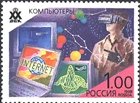 |
||
PCs. Devices which process information. The first computers were created in 1940s, the first two generations of they were rapid calculating devices. In early 1970s the first PCs appeared which are universal devices, able to perform logical and creative tasks. PSc are linked into networks by telephone lines which creates new ways of using information globally (Internet). The stamp shows various applications of PCs in day-to-day life.
| Face value | Size | Description | Price, mint | Price, used | Quantity |
|---|---|---|---|---|---|
| 1.00 | 50×37 | PCs. Devices which process information. The first computers were created in 1940s, the first two generations of they were rapid calculating devices. In early 1970s the first PCs appeared which are universal devices, able to perform logical and creative tasks. PSc are linked into networks by telephone lines which creates new ways of using information globally (Internet). The stamp shows various applications of PCs in day-to-day life. multicolor |
1.00 | 0.20 | 250000 |
Category:
Industry, construction, agriculture, technology : Space
Industry, construction, agriculture, technology : Energetics
Industry, construction, agriculture, technology : Aviation
Communication : Telecommunication
Science : Genetics
Science : Information technologies and communications
FDC:
no data





